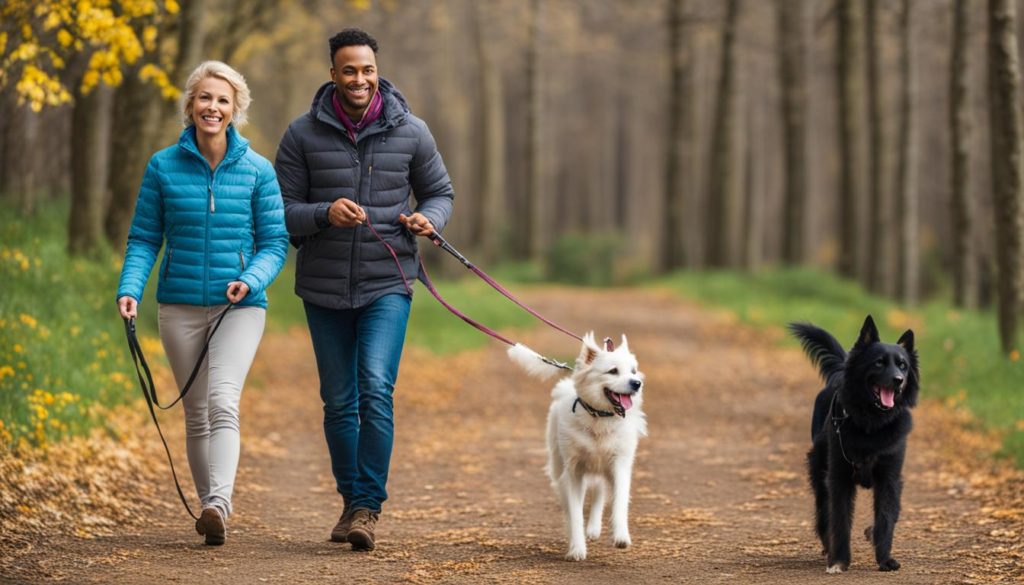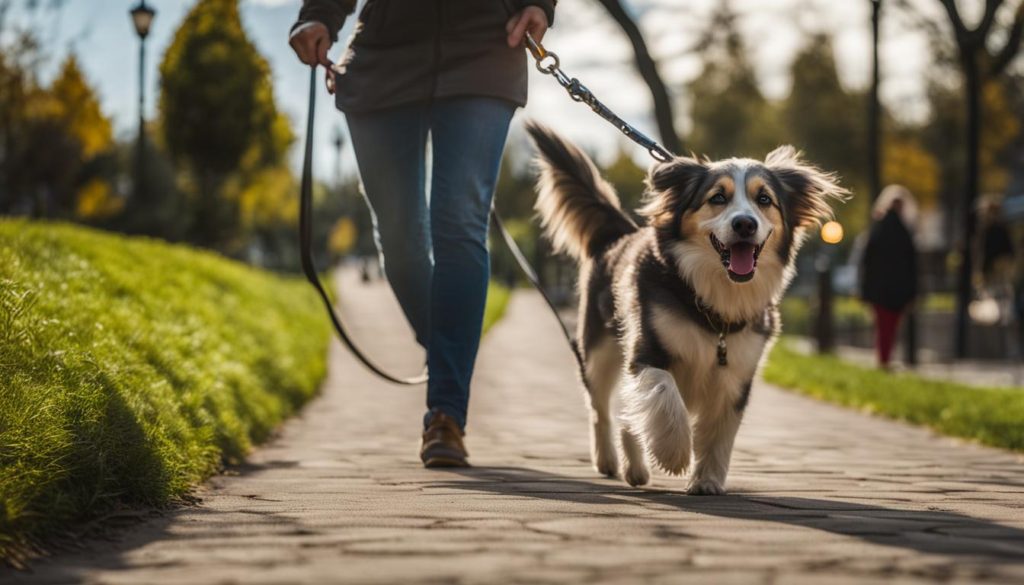As a dog behaviorist, I am often asked how to get a dog to walk calmly on a leash. Here are 7 tips to establish yourself as the pack leader and master the walk.
First, the walk starts the moment you grab the leash. Wait for your dog to be in a calm state before putting on the leash.
Second, walk through the door first with your dog following you to establish yourself as the leader.
Third, always walk in front of your dog to show them that you are in control.
Fourth, decide when your dog can sniff and relieve themselves during the walk.
Fifth, be aware of your own energy and maintain a calm, assertive state of mind.
Sixth, set aside dedicated time for the walk to meet your dog’s physical and mental needs.
Finally, end the walk by returning home the same way you left it and providing food and water as a reward.
Follow these steps and you’ll be walking your dog with confidence in no time!
The Importance of Leash Training for Dogs
Leash training is essential for ensuring the safety of your dog and teaching them basic obedience skills. It helps keep your dog safe when you’re out and about and allows you to maintain control over their behavior. Leash training also helps to build a positive relationship between you and your dog.
Teaching your dog leash manners through obedience training is crucial. Utilizing positive reinforcement training methods, such as rewards and praise, can make the experience enjoyable for both you and your furry friend. By using positive reinforcement, you are encouraging your dog to behave well on the leash and reinforcing desired behaviors.
Starting leash training from an early age, ideally around 8 weeks old, sets a strong foundation for obedience and good behavior throughout your dog’s life. It teaches your dog to stay close to you, follow your lead, and respond to commands effectively. This helps establish you as the pack leader, instilling a sense of trust and respect in your dog.
During leash training, it’s important to be patient and consistent. Start in a quiet and familiar environment, gradually introducing new challenges as your dog becomes more comfortable and confident. Remember to reward your dog whenever they demonstrate good leash manners, such as walking calmly beside you without pulling.
Leash training not only provides practical benefits but also strengthens the bond between you and your dog. It allows you to spend quality time together, enjoying walks and exploring the world around you. Your dog will learn to rely on you for guidance and security, enhancing their overall well-being and happiness.
Benefits of Leash Training for Dogs:
- Ensures safety during walks and outings
- Maintains control over your dog’s behavior
- Builds trust and respect between you and your dog
- Encourages obedience and good manners
- Strengthens the bond and relationship
By investing time and effort in leash training, you are setting your dog up for success in various environments. Whether you enjoy leisurely walks around the neighborhood or adventurous hikes in the great outdoors, a well-trained dog on a leash enhances the experience for both of you.
How to Leash Train Your Dog to Walk Beside You
To train your dog to walk beside you on a leash, follow these simple steps:
-
Start with a short leash in a quiet and enclosed area.
-
When your dog pulls on the leash, stop walking and stand still to show them that pulling is not acceptable.
-
Praise and reward your dog when they stay by your side and walk calmly.
-
If your dog gets distracted, gently redirect their attention back to you and keep walking.
-
Gradually increase the length of the leash as your dog learns to stay close to you.
This training will help your dog develop good leash manners and understand that they need to walk beside you.
How to Prevent Your Dog from Pulling on the Leash
To prevent your dog from pulling on the leash, follow these effective dog training techniques. By addressing the pulling behavior, you can ensure a pleasant walking experience for both you and your furry companion.
- When your dog pulls on the leash, stop walking and stand still. This teaches them that pulling is not acceptable.
- Once your dog stops pulling, reward them with praise and a treat. Positive reinforcement is key to reinforcing good behavior.
- If your dog gets distracted and starts to pull again, gently redirect their attention back to you using a command or a gentle tug on the leash.
- As your dog improves and walks without pulling, gradually increase the length of the leash to provide them with more freedom. This step-by-step approach allows for a gradual transition and reinforces their good behavior.
- Remember to maintain a calm and assertive energy during the walk. Dogs respond well to confident leaders.

Just like any dog training technique, consistency and patience are key to achieving success. With practice and perseverance, you can train your dog to walk calmly beside you, without the need for constant pulling.
Conclusion
Leash training is an essential aspect of dog behavior training and an effective technique for teaching your furry friend how to walk calmly on a leash. By implementing the dog training techniques outlined in this article, you can establish yourself as the pack leader and have a well-behaved walking companion.
Remember, leash training not only ensures the safety of your dog but also gives you control over their behavior. Using positive reinforcement techniques, such as rewarding good behavior, will help reinforce the desired leash manners. Patience is key during this process, as dogs may take time to understand and adjust to leash training.
Through leash training, you’ll not only improve your dog’s walking habits but also strengthen the bond between you and your canine companion. Enjoying pleasant walks together can be a rewarding and enjoyable experience for both you and your dog. Start leash training your dog today and witness the positive transformation in their behavior.
FAQ
How can I establish myself as the pack leader and master the walk with my dog?
To establish yourself as the pack leader and master the walk with your dog, wait for your dog to be in a calm state before putting on the leash. Walk through the door first with your dog following you to establish yourself as the leader. Always walk in front of your dog to show them that you are in control. Decide when your dog can sniff and relieve themselves during the walk. Be aware of your own energy and maintain a calm, assertive state of mind. Set aside dedicated time for the walk to meet your dog’s physical and mental needs. End the walk by returning home the same way you left it and provide food and water as a reward.
Why is leash training important for dogs?
Leash training is essential for ensuring the safety of your dog and teaching them basic obedience skills. It helps keep your dog safe when you’re out and about and allows you to maintain control over their behavior. Leash training also helps to build a positive relationship between you and your dog. It teaches them to stay close to you and obey commands, which increases their trust in you as their pack leader.
How can I leash train my dog to walk beside me?
To train your dog to walk beside you on a leash, start by walking them on a short leash in a quiet and enclosed area. Whenever your dog pulls on the leash, stop walking and stand still to show them that pulling is not acceptable. Praise and reward your dog when they stay by your side and walk calmly. If your dog gets distracted, gently redirect their attention back to you and keep walking. Gradually increase the length of the leash as your dog learns to stay close to you.
How can I prevent my dog from pulling on the leash?
To prevent your dog from pulling on the leash, use the same techniques as before, but with an added emphasis on stopping the pulling behavior. Whenever your dog pulls on the leash, again, stop walking and stand still. When your dog stops pulling, reward them with praise and a treat. Gently redirect their attention back to you if they get distracted. As your dog gets better at walking without pulling, gradually increase the length of the leash. If your dog starts to pull again, give a gentle tug on the leash or use a command like “No” or “Let’s go” to remind them to walk calmly beside you.
What are the benefits of leash training for dogs?
Leash training is an important skill to teach your dog. It ensures their safety and allows you to have control over their behavior. By leash training your dog, you can have a well-behaved walking companion. Plus, it strengthens the bond between you and your canine companion. Leash training not only benefits your dog but also gives you both the opportunity to enjoy pleasant walks together.
